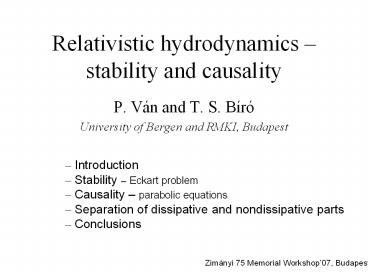Relativistic hydrodynamics - PowerPoint PPT Presentation
Title:
Relativistic hydrodynamics
Description:
Separation of dissipation. flow energy. physics of. Meaning? ... feelings on dissipation... Thermodynamics: Statics: Dynamics: Isotropic current-force functions: ... – PowerPoint PPT presentation
Number of Views:77
Avg rating:3.0/5.0
Title: Relativistic hydrodynamics
1
Relativistic hydrodynamics stability and
causality
- P. Ván and T. S. Bíró
- University of Bergen and RMKI, Budapest
- Introduction
- Stability Eckart problem
- Causality parabolic equations
- Separation of dissipative and nondissipative
parts - Conclusions
Zimányi 75 Memorial Workshop07, Budapest
2
Introduction
Nonrelativistic Relativistic Local
equilibrium (1st) Fourier, Navier-Stokes Eckart B
eyond local equilibrium Cattaneo-Vernotte,
Israel-Stewart, (2nd) gen. Navier-Stokes
Müller-Ruggieri Öttinger, Carter, etc..
Conceptual issues plaguing relativistic
hydrodynamics Causality first order is
bad noncausal second order is good -
causal Stability first order is bad
instable second order is good - stable
?
Dissipative nondissipative symmetric
part?
3
Stability of what and in what sense?
homogeneous equilibrium (thermodynamics
theory of stability of ) linear and
nonlinear linear necessary condition Eckart
theory instable due to heat conduction
water
Israel-Stewart theory ? strange
condition ?relaxation to the first order theory
(Geroch 1995, Lindblom 1995)
4
Structure of dissipative hydrodynamic theories
Irreversible thermodynamics (heuristic method)
Eckart term
5
Complete Eckart system
lt gt - symmetric traceless spacelike part
Equilibrium
6
exponential plane-waves
Stability condition for transverse modes
- root with a positive real part ? instability
- coupling of shear viscosity and heat conduction
Landau frame?
7
Causality hyperbolic or parabolic?
? Well posedness ? Speed of signal propagation
Second order linear partial differential equation
Corresponding equation of characteristics
i) Hyperbolic equation two distinct families of
real characteristics Parabolic equation one
distinct families of real characteristics Ellipti
c equation no real characteristics
Well posedness existence, unicity, continuous
dependence on initial data.
8
ii) () is transformation invariant
x
x
t
t
E.g.
9
Infinite speed of signal propagation? physics -
mathematics
Hydrodynamic range of validity ? mean free
path t collision time
Water at room temperature Fermi gas of light
quarks at
More complicated equations, more spacetime
dimensions, .
10
Second order theory? stability problematic ?
Landau choice? As long as it is acceptable
from a physical point of view. causality no
problem validity second order effects can be
important First order theory? stability very
problematic ? Landau choice? As long as it is
acceptable from a physical point of
view. Numerical problems!! causality small
problem estimation? validity second order
effects can be important Origin of stability
problem wrong separation of dissipative and
non dissipative terms and effects the choice of
velocity field is not free (e.g. entropy
production)
11
Separation of dissipation
physics of
flow energy
Separation condition
12
Meaning?
(a) energies total internal flow (mass?) (b)
velocity momentum (heat) flow energy heat
flux
13
Thermodynamics
normal with internal energy e, or
Statics
q dependence
14
(No Transcript)
15
Summary momentum density but heat flow
energy internal energy flow energy
ADDS entropy flux and
can ben justified (thermodynamic theory
construction Liu procedure) linear stability
of homogeneous equilibrium Thermodynamics
? stability of matter
16
Thank you for your attention!
17
(No Transcript)
18
Balance of entropy
Stable!
Net balances
19
Energy-momentum - general
Landau choice
20
Linearization
21
Routh-Hurwitz
thermodynamic stability
hydrodynamic stability
22
Eckart term
Ideal hydro hits the target. ? feelings on
dissipation
water
23
Thermodynamics
Statics
Dynamics
24
(No Transcript)
25
Isotropic current-force functions
Stability? For water blows up in
Let us eliminate q Landau convention? (not
stable - P. Romatshke)
26
Nonrelativistic experience a four vector
formalism
Energy units of mass
mass velocity (momentum ?) internal
energy velocity-momentum (relativistic?)
27
Nonrelativistic spacetime there is time
(absolute)
spacelike, timelike, vectors and
covectors, substantial time derivative
energy-momentum tensor
?
28
mass-momentum vector
total energy-momentum tensor
separation of dissipative and nondissiaptive
parts































